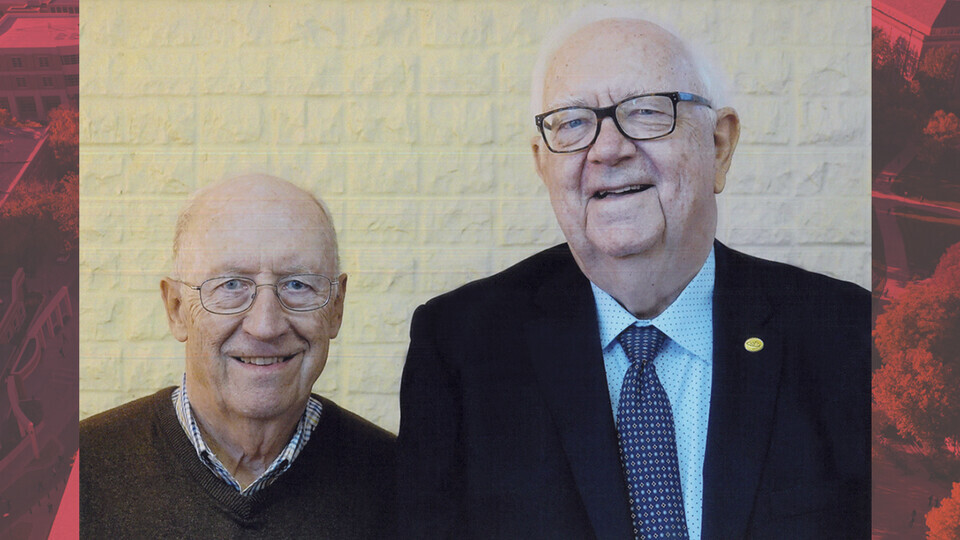
Small-scale interactions yielding greater-than-the-sum outcomes.
The same principle that defines condensed-matter physics — the professional passion and pursuit of the late David Sellmyer — continues to define the legacy of the Nebraska faculty member more than a year after his passing.
A lifetime of leadership and camaraderie, which included Sellmyer’s enduring friendship with fellow Husker professor John Woollam, would inspire the latter to establish an endowed graduate fellowship in the former’s name. This fall, several doctoral students in the Department of Physics and Astronomy will represent the inaugural cohort of David J. Sellmyer Fellows, receiving financial support to study the namesake’s favored field.
“We are very grateful to John for his generosity toward the department and for supporting the development of the next generation of physicists,” said Ken Bloom, chair of physics and astronomy at Nebraska. “In a competitive marketplace for strong physics students, this fellowship is a tool that we can use to attract the very best to Lincoln.”
Sellmyer himself came to Nebraska in 1972, fresh from a seven-year stint at the Massachusetts Institute of Technology. In 1979, he persuaded Woollam — once his doctoral classmate at Michigan State University, then a 13-year employee of NASA — to join him in Lincoln. Over the next four-plus decades, the pair would emerge as luminaries in their respective departments: Sellmyer in physics, Woollam in electrical and computer engineering.
“David has a wonderful collaborative spirit,” Woollam said of his friend in 2021. “He’s a true leader and an inspiration for others, with wisdom, competence and kindness to share.”
That spirit manifested, in part, as mentorship: Sellmyer advised roughly 100 graduate students and postdoctoral researchers across his nearly 50 years at the University of Nebraska–Lincoln. But he looked after junior faculty, too, including those who would rise to prominence in their own right. Christian Binek, now a Charles Bessey Professor of physics and the scientific director of a $20 million project on quantum-focused materials, counted himself among those early-career protégés.
“Dave was like a gentle father figure, inspiring many of us through his work ethic, his vision and focus,” Binek said. “He always looked for the bigger picture, seeking funding not just for his work but altruistically for large groups of faculty.”
In 1988, Sellmyer founded what came to be known as the Nebraska Center for Materials and Nanoscience. He directed the center until 2019, by which point the infrastructure he spearheaded had helped secure tens of millions of dollars in research funding. Under Sellmyer’s stewardship, that success also laid the groundwork for Nebraska to later house a Materials Research Science and Engineering Center, one of fewer than two dozen funded by the National Science Foundation.
“He was particularly good at assembling teams of researchers, not just within the department but across the university, that could do more together,” Bloom said.
Today, more Husker faculty and graduate students research condensed-matter physics than any other discipline in the Department of Physics and Astronomy. Binek said the study of nanomaterials, in particular — an area in which Sellmyer published numerous breakthroughs on magnetism — will prove central to resolving some of the century’s most ambitious challenges: superconductivity at room temperature, sustained nuclear fusion, interstellar travel at near-light speed.
The endowed fellowship, he said, will allow Nebraska to continue researching those challenges while sustaining the memory of a legend who made the most of every opportunity and created countless more.
“The excitement and significance of materials science is ever-growing,” said Binek, who now directs the Nebraska Center for Materials and Nanoscience. “Virtually every hard problem in physics and engineering has a materials science component to it.
“The condensed-matter physics community in the Department of Physics and Astronomy … is in a position to educate the next generation of graduate students making scientific and technological breakthroughs in critical areas. Graduate students who have the privilege of holding a David Sellmyer Fellowship will be inspired by his example of turning a vision into reality.”







